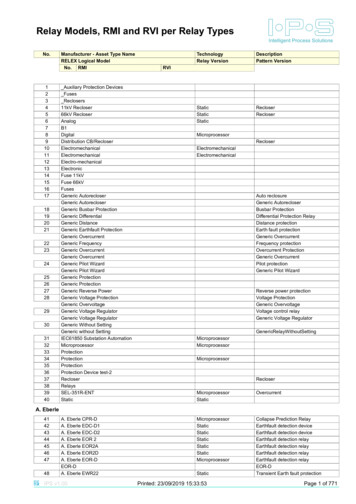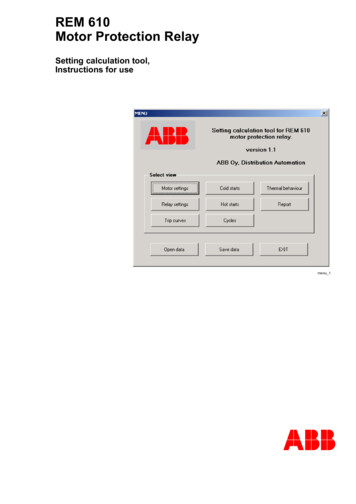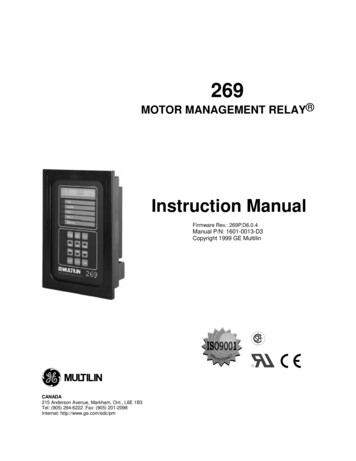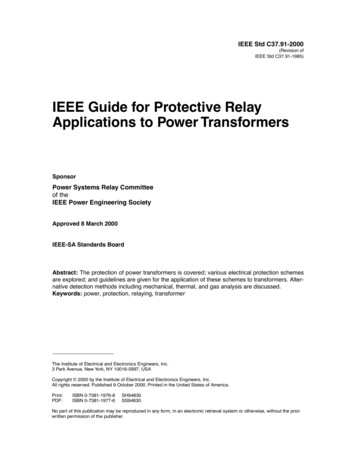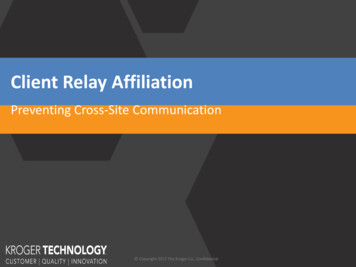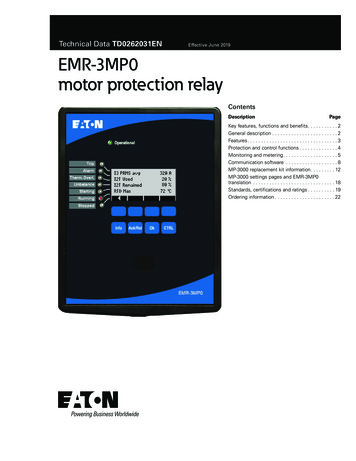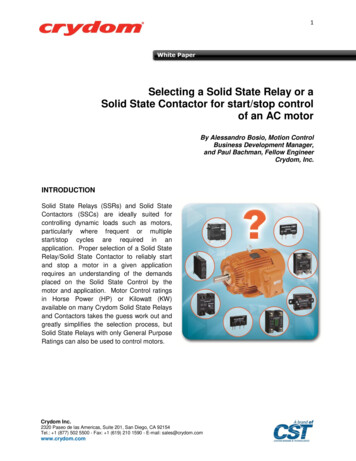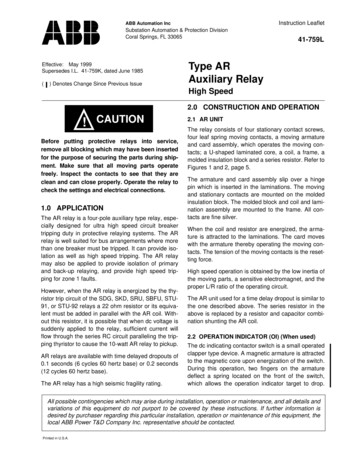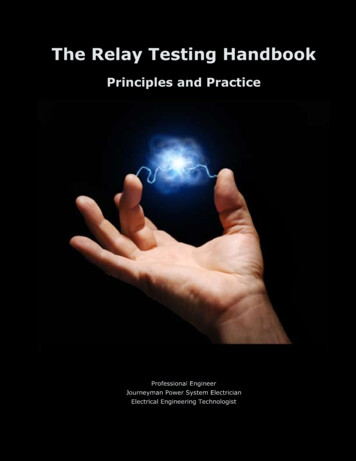
Transcription
TheRelayTesting HandbookPrinciplesand PracticeProfessionalEngineerJourneymanPowerSystem ElectricianElectricalEngineeringTechnologist
Table of ContentsAuthor’s NoteAcknowledgmentsChapter 1: Electrical Fundamentals1. The Three-Phase Electrical System2. Transformers3. Instrument Transformers4. Fault Types5. Grounding6. Sequence Components7. Fault Types and Sequence ComponentsChapter 2: Introduction to Protective Relays1. What are Protective Relays?2. Time Coordination Curves (TCC) and CoordinationChapter 3: A Brief History of Protective Relaysvvii11273440475258656573831. Electromechanical Relays2. Solid-State Relays3. Microprocessor Based Relays838787Chapter 4: Relay Testing Fundamentals951.2.3.4.Reasons for Relay TestingRelay Testing EquipmentRelay Testing MethodsRelay Test ProceduresChapter 5: Test Sheets and Documentation1.2.3.4.5.6.7.Your Company Name and LogoProject DetailsNameplate DataCT and PT RatiosComments and NotesMetering Test DataInput / Output Tests9598101109135136136137138138138139ix
Principles and Practice8. Element Test Results9. Element Characteristics10. Final Output Checks11. Test Sheet Template12. Final ReportChapter 6: Testing Overvoltage (59) Protection1.2.3.4.5.ApplicationSettingsPickup TestingTiming TestsTips and Tricks to Overcome Common ObstaclesChapter 7: Undervoltage (27) Protection Testing1.2.3.4.5.ApplicationSettingsPickup TestingTiming TestsTips and Tricks to Overcome Common ObstaclesChapter 8: Over/Under Frequency (81) Protection 165165166169175181183ApplicationSettingsPickup TestingTiming TestsTips and Tricks to Overcome Common Obstacles183185187192193Chapter 9: Instantaneous Overcurrent (50) Element Testing1951.2.3.4.5.6.ApplicationSettingsPickup TestingTiming TestsResidual Neutral Instantaneous Overcurrent ProtectionTips and Tricks to Overcome Common ObstaclesChapter 10: Time Overcurrent (51) Element Testing1.2.3.4.5.6.7.xApplicationSettingsPickup TestingTiming TestsReset TestsResidual Neutral Time Overcurrent ProtectionTips and Tricks to Overcome Common 8
Principles and PracticeChapter 11: Directional Overcurrent (67) Element kup TestingTiming Test ProceduresTips and Tricks to Overcome Common ObstaclesChapter 12: Simple Percent Differential (87) Element ifferential Pickup TestingRestrained-Differential Timing Test ProcedureRestrained-Differential Slope TestingTips and Tricks to Overcome Common ObstaclesChapter 13: Percent Differential (87) Element t Transformer Connections3-Phase Restrained-Differential Pickup TestingRestrained-Differential Timing Test Procedure3-Phase Restrained-Differential Slope Testing1-Phase Restrained-Differential Slope TestingHarmonic Restraint TestingTips and Tricks to Overcome Common ObstaclesChapter 14: Unrestrained-Differential Testing1.2.3.4.5.6.SettingsTest-Set ConnectionsSimple Pickup Test ProcedureAlternate Pickup Test ProcedureTiming Test ProcedureTips and Tricks to Overcome Common ObstaclesChapter 15: Line Distance (21) Element Testing1.2.3.4.5.6.Impedance RelaysSettingsPreventing Interference in Digital Relays3-Phase Line Distance Protection TestingPhase-to-Phase Line Distance Protection TestingPhase-to-Ground Line Distance Protection 385390401405407425451xi
Principles and PracticeChapter 16: Understanding Digital Logic1.2.3.4.5.6.7.Understanding LogicRelay LabelsInternal Relay Control SchemesIndividual Element SchemesBinary RelaysArithmetic (Math) SchemeGeneral Electric FlexLogic Chapter 17: Review the Application1. Introduction2. Collecting InformationChapter 18: Preparing to Test1.2.3.4.5.Prepare to TestEstablish CommunicationApply SettingsConnect Your Relay Test-SetCreating the Test PlanChapter 19: Testing the Relay1.2.3.4.5.6.7.Perform Relay Self-checksVerify Digital Inputs and OutputsVerify Current and Voltage InputsElement TestingFinal Output TestsPrepare Relay for ServiceFinal x627xii
Table of FiguresFigure 1-1: Simple Single-Phase GeneratorFigure 1-2: Simple Three-Phase GeneratorFigure 1-3: Phase Sequence ExamplesFigure 1-4: Phasor Diagram ExampleFigure 1-5: Electrical Diagram ComparisonFigure 1-6: Electrical Diagram Comparison with Van ReferenceFigure 1-7: Phasor Diagram 1Figure 1-8: Phasor Diagram 2Figure 1-9: Phasor Diagram 3Figure 1-10: A-B-C / A-C-B Phasor DiagramsFigure 1-11: Current and Voltage PhasorsFigure 1-12: Vector Diagrams on Different AxisFigure 1-13: Wye ConnectionFigure 1-14: Phase to Line ConversionFigure 1-15: Delta/Wye Connected Vector DiagramFigure 1-16: Delta ConnectionFigure 1-17: Delta Connection Vector Diagram for Balanced System with 30 LagFigure 1-18: Watts - Current and Voltage Are In-PhaseFigure 1-19: Inductive VARs - Current Lags the Voltage by 30ºFigure 1-20: Capacitive VARs - Current Leads the VoltageFigure 1-21: Three-Phase Power FormulasFigure 1-22: Three-Phase Power Formulas Assuming Balanced ConditionsFigure 1-23: Three-Phase Power Triangle - Watts OnlyFigure 1-24: Power Triangle - Only Inductive VARsFigure 1-25: Power Triangle - Only Capacitive VARsFigure 1-26: Power TriangleFigure 1-27: Example Three-Phase Power/VARS/VA Formula CalculationsFigure 1-28: Simple Transformer ConstructionFigure 1-29: Transformer Voltage Ratio CalculationFigure 1-30: Transformer Current Ratio CalculationFigure 1-31: Wye-Delta Transformer ConnectionsFigure 1-32: Wye-Delta Transformer CalculationsFigure 1-33: Delta-Wye Transformer ConnectionsFigure 1-34: Delta-Wye Transformer 23242428292931313232xiii
Principles and PracticeFigure 1-35: Wye-Wye Transformer ConnectionsFigure 1-36: Auto-Transformer ConnectionsFigure 1-37: Delta-Delta Transformer ConnectionsFigure 1-38: Wye-Wye and Delta-Delta Transformer CalculationsFigure 1-39: CT Ratio CalculationsFigure 1-40: CT Polarity ConnectionsFigure 1-41: CT Accuracy ClassFigure 1-42: PT Voltage Ratio CalculationFigure 1-43: 3-Wire Delta PT ConfigurationsFigure 1-44: 4-Wire Wye PT ConfigurationsFigure 1-45: Nominal PT VoltagesFigure 1-46: Three-Phase Fault 3-Line DrawingFigure 1-47: Three-Phase Fault Phasor DiagramFigure 1-48: Phase-Phase Fault 3-Line DrawingFigure 1-49: Fault Current vs. Injected CurrentFigure 1-50: Phase-Phase FaultFigure 1-51: Phase-Ground Fault 3-Line DrawingFigure 1-52: Phase-Ground FaultFigure 1-53: Phase-Phase-Ground Fault 3-Line DrawingFigure 1-54: Phase-Phase-Ground FaultFigure 1-55: Solidly Grounded SystemFigure 1-56: Resistive Grounded SystemFigure 1-57: NGR Maximum Ground Fault Current FormulaFigure 1-58: NGR Maximum Ground Fault Voltage FormulaFigure 1-59: NGR Ground Fault Voltage FormulaFigure 1-60: Neutral Grounding TransformerFigure 1-61: NGTX Effective Resistance FormulaFigure 1-62: NGTX Ground Fault Voltage FormulaFigure 1-63: Open Corner Delta Ground DetectorFigure 1-64: Open Corner Delta Normal PhasorsFigure 1-65: Open Corner Delta with One Phase GroundedFigure 1-66: Positive Sequence FormulasFigure 1-67: Positive Sequence CalculationFigure 1-68: Negative Sequence FormulasFigure 1-69: Negative Sequence Calculation 1Figure 1-70: Negative Sequence Calculation 2Figure 1-71: Zero Sequence FormulasFigure 1-72: Zero Sequence Calculation 1Figure 1-73: Zero Sequence Calculation 2Figure 2-1: Zones of ProtectionFigure 2-2: Overlapping Zones of ProtectionFigure 2-3: Non-Overlapping Zone of Protection ExampleFigure 2-4: Protective Relay CoordinationFigure 2-5: Compensation for Normal System 172
Principles and PracticeFigure 2-6: Fault Study Short Circuit CurrentsFigure 2-7: Calculation to Convert Current to Base VoltageFigure 2-8: Example Time Coordination Curve (TCC)Figure 2-9: Reference Voltage ConversionsFigure 2-10: Damage CurvesFigure 2-11: Damage Curve TCCFigure 2-12: Single Line DrawingFigure 2-13: TCC Curve #1Figure 2-14: TCC Curve #2Figure 2-15: TCC Curve #3Figure 3-1: Example of Clapper Style RelayFigure 3-2: Typical Electromechanical Relay with Timing DiskFigure 3-3: Example of an Electromechanical Relay Polarizing ElementFigure 3-4: Typical Polarizing Element Electrical SchematicFigure 3-5: Typical Electromechanical Overcurrent Trip SchematicFigure 3-6: Simple Microprocessor Operation FlowchartFigure 3-7: Simple Microprocessor Internal SchematicFigure 3-8: Typical Electromechanical Overcurrent Trip SchematicFigure 3-9: Typical Digital Relay Trip SchematicFigure 3-10: Electromechanical Generator Protection PanelFigure 3-11: Digital Generator Protection PanelFigure 4-1: 3-Phase Relay Input Connection Using Two SourcesFigure 4-2: Steady State Pickup TestingFigure 4-3: Dynamic On/Off WaveformFigure 4-4: Simple Dynamic Test WaveformFigure 4-5: Complex Dynamic Waveform (Compliments of Manta Test Systems)Figure 4-6: System Modeling Waveform (Compliments of Manta Test Systems)Figure 4-7: Graph of Pickup TestFigure 4-8: Percent Error FormulaFigure 4-9: Beckwith Electric M-3310 Relay Element SpecificationsFigure 4-10: Example Pickup Percent Error CalculationFigure 4-11: Simple Off/On Timing TestFigure 4-12: Dynamic On/Off TestingFigure 4-13: Beckwith Electric M-3310 Relay Element SpecificationsFigure 4-14: Example Timing Test Percent Error CalculationFigure 4-15: SEL-311C Relay Element SpecificationsFigure 4-16: SEL-311C Output Contact SpecificationsFigure 4-17: Manta Test Systems MTS-1710 Technical SpecificationsFigure 4-18: 50-Element Maximum Expected ErrorFigure 4-19: 50-Element Ideal Combination TestFigure 4-20: 50-Element Combination TestFigure 4-21: 21-Element Combination TestFigure 4-22: 21-Element Dual Zone Combination TestFigure 4-23: 21-Element Dual Zone Combination 22123126127128xv
Principles and PracticeFigure 4-24: System Modeling Waveform (Compliments of Manta Test Systems)Figure 5-1: Example Test Sheet HeaderFigure 5-2: Example Test Sheet with Project DetailsFigure 5-3: Example Test Sheet with Nameplate DataFigure 5-4: Example Test Sheet with NotesFigure 5-5: Example Test Sheet with MeteringFigure 5-6: Example Test Sheet with Input / Output VerificationFigure 5-7: Example Test Sheet for Element Pickup TestsFigure 5-8: Example Test Sheet #2 for Element Pickup TestFigure 5-9: Test Sheet Example ElementFigure 5-10: Example Test Sheet with Element CharacteristicsFigure 5-11: Example Test Sheet with Final Output CheckFigure 6-1: Example 59-Element Settings and Test Results with Phase-to-Neutral VoltagesFigure 6-2: Example 59-Element Settings and Test Results with Phase-to-Phase VoltagesFigure 6-3: Substitution Chart for 59-ProceduresFigure 6-4: Simple Phase-to-Neutral Overvoltage ConnectionsFigure 6-5: Simple Phase-to-Phase Overvoltage ConnectionsFigure 6-6: Phase-to-Phase Overvoltage Connections with 2 Voltage SourcesFigure 6-7: GE/Multilin SR-750 Overvoltage Relay SpecificationsFigure 6-8: GE/Multilin SR-750 Overvoltage Relay SpecificationsFigure 6-9: Inverse Curve for Overvoltage ProtectionFigure 6-10: GE/Multilin SR-489 Overvoltage Relay SpecificationsFigure 7-1: 27-Element Example Settings and Test ResultsFigure 7-2: Substitution Chart for 27-ProceduresFigure 7-3: Simple Phase-to-Neutral Undervoltage ConnectionsFigure 7-4: Simple Phase-to-Phase Undervoltage ConnectionsFigure 7-5: Phase-to-Phase Undervoltage Connections with 2 Voltage SourcesFigure 7-6: GE D-60 Undervoltage Relay SpecificationsFigure 7-7: GE D-60 Undervoltage Relay SpecificationsFigure 7-8: Undervoltage Inverse CurveFigure 8-1: Generator Trip Frequency RequirementsFigure 8-2: 81-Element Example Settings and Test ResultsFigure 8-3: Simple Phase-to-Neutral Frequency Test ConnectionsFigure 8-4: Simple Phase-to-Phase Overvoltage ConnectionsFigure 8-5: Phase-to-Phase Overvoltage Connections with 2 Voltage SourcesFigure 8-6: SEL-300G Frequency SpecificationsFigure 9-1: Ground Fault Protection Single-Line DrawingFigure 9-2: Ground Protection TCCFigure 9-3: 50/51 TCC #1Figure 9-4: 50/51 TCC #2Figure 9-5: 50/51 TCC #3Figure 9-6: 50/51 TCC #4Figure 9-7: Simple Instantaneous Overcurrent ConnectionsFigure 9-8: High Current Connections 7188189189191196196197197197197201201
Principles and PracticeFigure 9-9: High Current Connections #2Figure 9-10: Neutral or Residual Ground Bypass ConnectionFigure 9-11: Neutral or Residual Ground Bypass Connection via Ø-Ø ConnectionFigure 9-12: Pickup Test GraphFigure 9-13: Pickup Test Graph via Jogging MethodFigure 9-14: 50-Element Timing TestFigure 9-15: GE D-60 Relay Overcurrent Technical SpecificationsFigure 9-16: GE D-60 Relay Output Contact Technical SpecificationsFigure 9-17: Manta Test Systems M-1710 Technical SpecificationsFigure 9-18: 50-Element Minimum PickupFigure 9-19: 50-Element Alternate Relay ConnectionFigure 10-1: 51-Element North American CurvesFigure 10-2: 51-Element IEC European CurvesFigure 10-3: ANSI Extremely Inverse with Different Pickup SettingsFigure 10-4: ANSI Extremely Inverse with Different Timing SettingsFigure 10-5: Simple Time Overcurrent ConnectionsFigure 10-6: High Current Connections #1Figure 10-7: High Current Connections #2Figure 10-8: Neutral or Residual Ground Bypass ConnectionFigure 10-9: Neutral or Residual Ground Bypass Connection via Ø-Ø ConnectionFigure 10-10: Pickup Test GraphFigure 10-11: SEL-311C 51 Time Overcurrent SpecificationsFigure 10-12: 51-Element North American CurvesFigure 10-13: 51-Element Timing TestFigure 10-14: 51-Element SEL-311C Timing Curve Characteristic FormulasFigure 10-15: 51-Elem
Figure 1-15: Delta/Wye Connected Vector Diagram 16 Figure 1-16: Delta Connection 17 Figure 1-17: Delta Connection Vector Diagram for Balanced System with 30 Lag 17 Figure 1-18: Watts - Current and Voltage Are In-Phase 18 Figure 1-19: Inductive VARs - Current Lags the Voltage by 30º 19 Figure 1-20: Capacitive VARs - Current Leads the Voltage 20 Figure 1-21: Three-Phase Power Formulas 21 .
